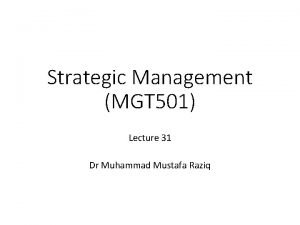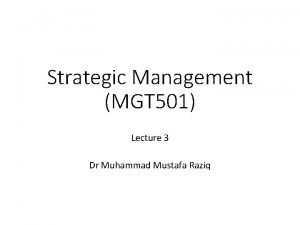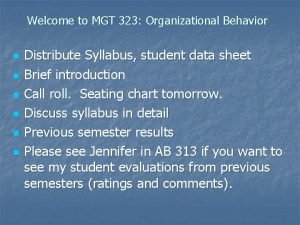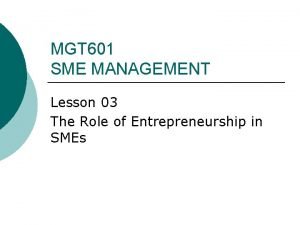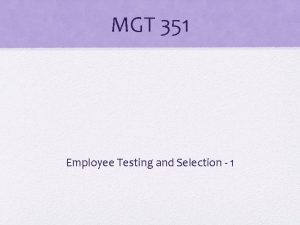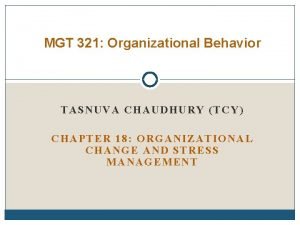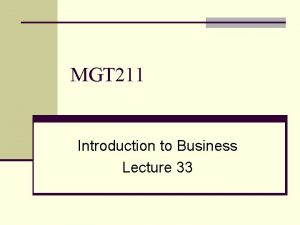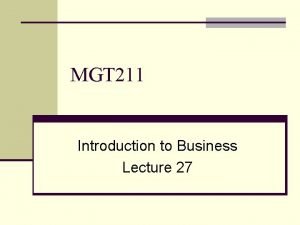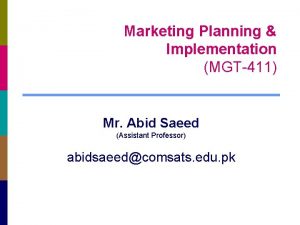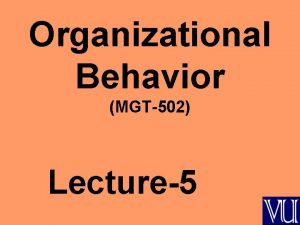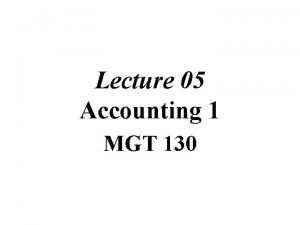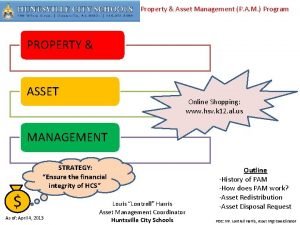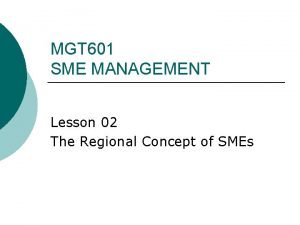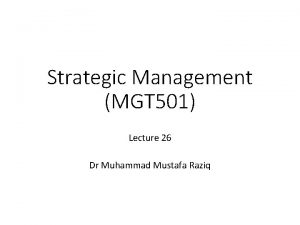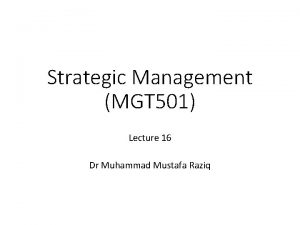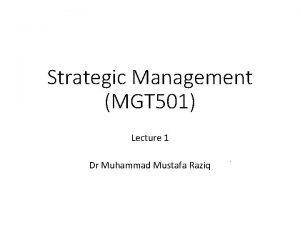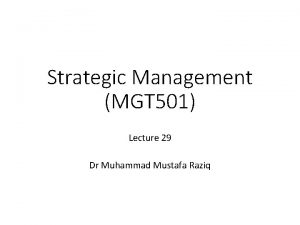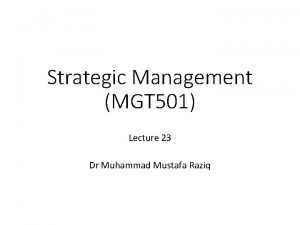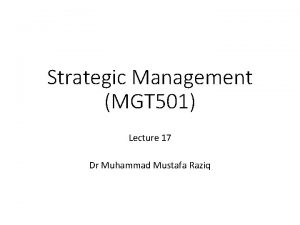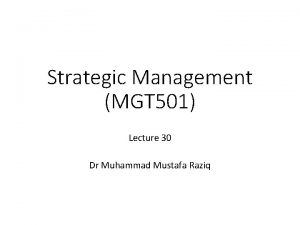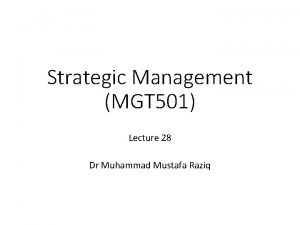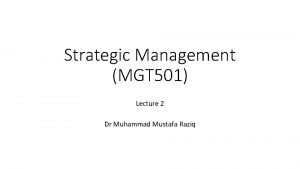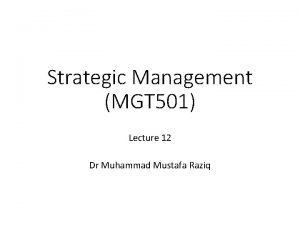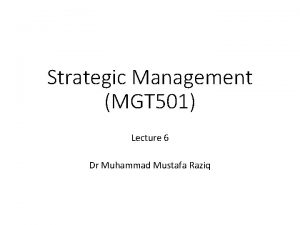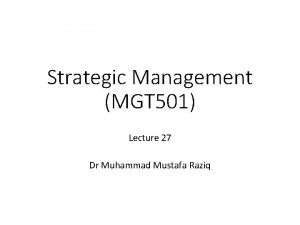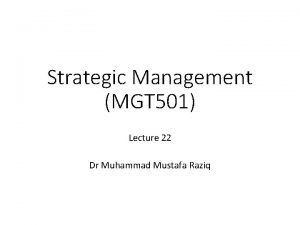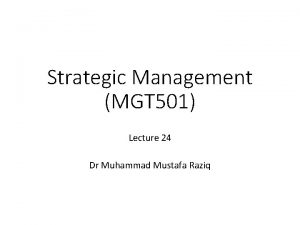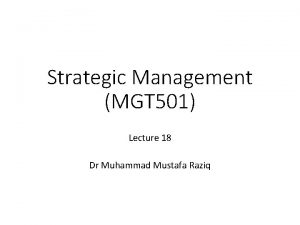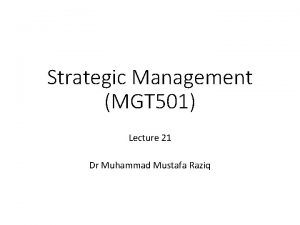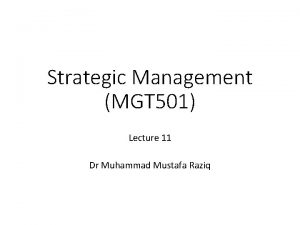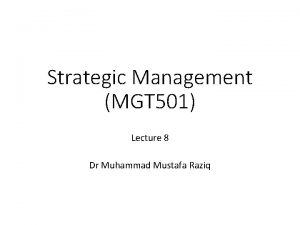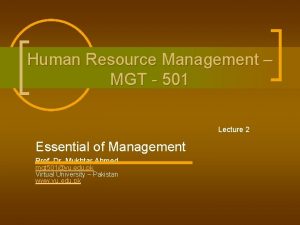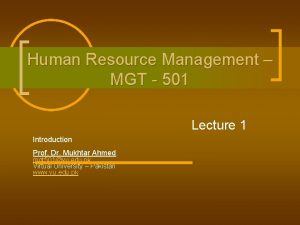Strategic Management MGT 501 Lecture 19 Dr Muhammad

























- Slides: 25

Strategic Management (MGT 501) Lecture 19 Dr Muhammad Mustafa Raziq

Topic Covered in the Previous Lecture • First Mover Advantages • Strategic Analysis, Strategic Options, Strategy Choice • Norms of Strategy making

Topics to be covered in this lecture • Norm of Strategy Making • Offensive strategies and defensive strategies • Exercise

5. 8. 1. Optimal Strategy • While taking strategic decisions the firm must consider what actions others will take. The others include competitors, stakeholders, employees, customers etc. • There is no best strategy for all situations and best is always conditional • Optimal strategy is conditional on situational parameters • Options that are strategically stronger relative to other options are called dominant strategies • A dominant strategy is one whose pay off in any outcome relative to all other feasible strategies is higher

5. 8. 2. Blue Ocean Strategy • Red ocean strategy is the conventional strategy formulation to compete in existing market space - Blue ocean strategy aims to create uncontested market space, making competition irrelevant, by making new demand from noncustomers as well. • This new demand is created by reaching beyond the existing demand, by reconstructing market boundaries • It involves defining the buyer groups, finding out complementary offerings, rethinking and recrafting the orientation of the industry • Unexplored customers are targeted by the strategy planner or unattended aspects of buyer experience cycle are targeted such as delivery, use, supplements, maintenance, disposal, reuse, recycle, water energy use in operations, making purchase and payments etc.

5. 8. 3. Exit Strategies • Exit may be in different forms and structures • A company with multiple businesses would decide to exit one of the business in order to focus on the rest and then grow. • The exit may be by sale of a portion of the stake or share or full sell out depending or many factors • A single business may decide to exit from certain territories or exit from a product line • A firm may divest portions of its share not only to bring in more money, but also to get partners with required strengths to take the firm to a higher level or to take the firm to a growth trajectory • Exit may be for venturing into a new business that has more potential to grow

5. 9. Offensive and Defensive Strategies • Defensive Strategies: • Some of the defensive strategies for achieving cost advantage are as follows: • • Economies of scale and scope Utilizing the experience curve Skills and expertise acquisition for internal capability building Technology upgrade Product design Distribution efficiency Sourcing strategy

5. 9. Offensive and Defensive Strategies (continued) • Defensive Strategies: • Building up consumer’s cost of switching to other products through the following actions are also defensive strategies • Brand equity, loyalty, and remember-ability • Increasing consumers’ brand-specific confidence • Increasing consumers’ brand-specific investments in skills and knowledge • Framing of consumer’s perception • Incentives for repeat purchase and use • Product design, which requires supplementary products that are captive • Network effects

5. 9. Offensive and Defensive Strategies (continued) • Offensive Strategies: • Strategy to gain exclusive commitment of the supply members and product marketing chain members through certain proactive, pre-emptive actions are offensive strategies. • When there is a blockade of the competitor’s access to raw materials and/or markets • There may also be threats of aggressive responses such as price reduction that influence potential entrant’s decisions

5. 9. Offensive and Defensive Strategies (continued) • Offensive Strategies: Horizontal and vertical integration Investments in brand-specific assets Patent for core technology Lobbying for favorable public policies Demonstrating a reputation for toughness and cost superiority • Pre-emptive investments in excess capacity • • •

5. 9. 1. Strategic Positioning and Repositioning • In order to win, a firm following either an offensive or defensive strategy needs to reposition itself often, which is a part of the execution strategy planned in advance. • Positioning is the act of designing the company’s offerings and image to occupy a distant place in the target markets mind (Kotler, 2000) • Repositioning is sometimes understood as turnaround as the attempt of both is to improve the firm’s value proposition when performance is challenged. However both are different in terms of the nature, scope and path of change. Turnaround is a radical form of strategic change induced by performance decline that threatens the very existence of the organization • Generally efficiency led-moves, rather than entrepreneurial initiatives are associated with successful turnarounds, whereas strategic repositioning is a corporate entrepreneurial initiative.

Exercise • Question 1: • You have opened a retail store that sells stitched women clothes. Your task now is to develop a strategic retail plan for your business.

The strategic Retail Planning Process • Developing a strategic retail plan involves the following steps: • • Define the Business Mission Conduct a Situation Audit Identify Strategic Opportunities Evaluate Strategic Opportunities Establish specific objectives and allocate resources Develop a retail mix to implement strategy Evaluate performance and make adjustments

Define the Business Mission • A mission statement describes the organization purpose – it describes the objectives and the activities the organization intends to undertake – mission statement requires the business to answer the following five questions: • • • What business are we in? What should be our business in the future? Who are our customers? What are our capabilities? What do we want to accomplish? To be the leading retailer of good quality and moderatelypriced stitched clothes for women in Rawalpindi/Islamabad, and achieve a stable income of Rs. 10, 000 per year

Conduct a Situation Audit • Market Factors: • Market size, market growth (growing, mature or declining market), seasonality (is it seasonal or all year), and business cycles (is the market affected (such as for cars) or unaffected (such as for food) by economic conditions) • Competitive Factors – competition is affected by: • Barriers to entry (caused by for example economy of scale, customer loyalty, and location availability) • Bargaining power of suppliers (when there are only few a suppliers and so have the opportunity to dictate the prices and delivery terms)

Conduct a Situation Audit • Competitive rivalry (frequency and intensity of reactions by the competitors to the actions of the competing firm) • When rivalry is high: • Price wars erupt; employee raids occur; advertising and promotion expense increase; and profit potential falls. • Rivalry may increase with: • A large number of same sized competitors • Slow growth • High fixed costs • Lack of perceived differences between competing retailers

Conduct a Situation Audit • Environmental Factors – factors that can affect market attractiveness are: • Technological • With the rapid change in technology existing competitors may be threatened by new entrants that have the capability of new technology. • Economic (some business are more affected by economic conditions other less) • Regulatory (for example some laws may deter foreign companies to enter to promote the local industry) • Social (markets with diversified trends in demographics, lifestyles, attitudes, and personal values – where there is a simultaneous need to appeal multiple types of customers)

Conduct a Situation Audit • Analysis of Strengths and Weaknesses with respect to internal capabilities • Rate the capabilities (such as management, financial resources, operations, production, inventory, locations, and customers) from poor, limited, good, to excellent.

Identify Strategic Opportunities • What are the opportunities to increase retail sales – are they in: • Market penetration and/or market expansion and/or format development and/or diversification?

Evaluate Strategic Opportunities • Evaluate opportunities identified in the situation audit – purpose is for the business to determine the potential to establish a sustainable competitive advantage, and reap long-term profits from the opportunities evaluated

Establish specific objectives and allocate resources • Establish specific objective for each opportunity evaluated in the previous step – with the overall objective reflected in the mission statement, the specific objectives are goals towards achieving the overall objective – the specific objectives have three components: • The level of performance required to achieve the objective • Time frame for the objective to be achieved • The level of investment needed to achieve the objective

Develop a retail mix to implement strategy • Develop a retail mix (i. e. , store locations, store operations, merchandising, pricing, store image, promotion) and control and evaluate performance

Evaluate performance and make adjustments • If the business is meeting or exceeding its objectives, changes aren't needed – if not, reanalysis is required

Summary of the topics covered in this lecture • Norm of Strategy Making • Offensive strategies and defensive strategies • Exercise

Topics for the next lecture • Benchmarking and Industry Standards • Resource-led Strategies • Strategic Advantage Analysis • Open Strategy
 Mgt 501
Mgt 501 Mgt 501
Mgt 501 Mgt 501
Mgt 501 اا
اا Sami allahu liman hamidah meaning
Sami allahu liman hamidah meaning Strategic management lecture
Strategic management lecture Resource based model
Resource based model Strategy analysis and choice largely involves making
Strategy analysis and choice largely involves making 01:640:244 lecture notes - lecture 15: plat, idah, farad
01:640:244 lecture notes - lecture 15: plat, idah, farad Mgt 323
Mgt 323 Scope management accounting
Scope management accounting Mgt 601
Mgt 601 Mgt 351 nsu course outline
Mgt 351 nsu course outline Mgt 340 assignment
Mgt 340 assignment Mgt321
Mgt321 Mgt 211
Mgt 211 Luyana211
Luyana211 Mgt 411
Mgt 411 Mgt 385
Mgt 385 Portfolio plan example
Portfolio plan example Mgt502
Mgt502 Mgt 130
Mgt 130 Retail financial mgt
Retail financial mgt Pam program
Pam program Mgt 610
Mgt 610 Sme management definition
Sme management definition
